
Answering the question of what safety equipment is required on a boat in Florida can be challenging because everything depends on vessel type and size. Life jackets, visual distress signals, navigation lights, backfire flame control, and fire extinguishers are some of the most important.
Of course, boat safety equipments required on Florida watercraft can vary in quantity and other parameters. So, please continue reading to learn the nitty-gritty of boat safety requirements Florida boaters should know.
Table of Contents
List of Boat Safety Equipment Required Under Florida Law
According to Florida law, specifically the state’s Chapter 327 (Vessel Safety) and Chapter 328 (Vessels: Title Certificates; Liens; Certifications) statutes, all Florida boat owners and operators must ensure their watercraft carries, stores, and maintains US Coast Guard-required safety equipment.
Here is a checklist of the required items on a boat in Florida.
1. Kayaks and canoes less than 16 feet long
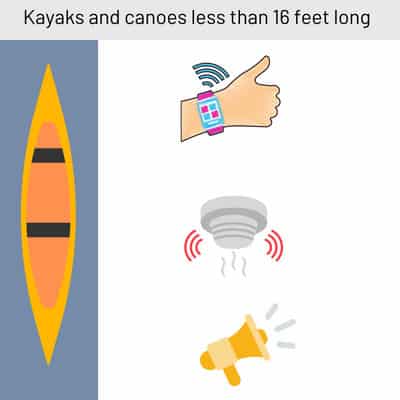
You might think kayakers and canoers do not have to worry about bringing any safety equipment. However, the truth is that they require the following safety equipment:
- One accessible and wearable US Coast Guard-approved Type I, II, III, or V personal flotation device per person
- Visual distress signaling device, especially at night. The device must have a manufacturing date within 3,5 years. Some recommended visual distress signaling devices include aerial red, orange smoke, and red meteor flares.
- One horn, whistle, or another sound-producing device.
2. Boats less than 16 feet long
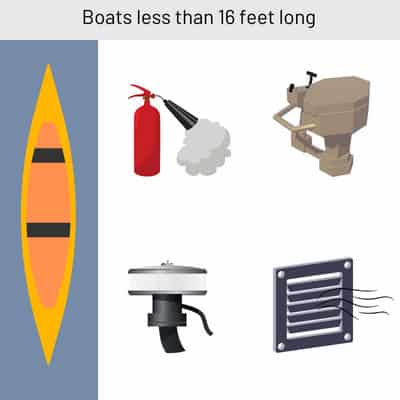
Safety equipment necessary on a 15 foot boat is similar to canoes and kayaks less than 16 feet long. However, additional items are crucial.
- One B-I fire extinguisher, but only on boats with permanent fuel tanks, enclosed living quarters, and onboard engines
- At least one USCG-certified Type I, II, or III marine sanitation device, but only for boats with integrated toilets
- One USCG-approved backfire flame arrestor device per carburetor, but only on petrol-powered onboard engines
- One USCG-standard ventilation system, but only on post-August 1980 boats with enclosed petrol-powered engine compartments
3. Boats between 16 and 25 feet, 11.9 inches long
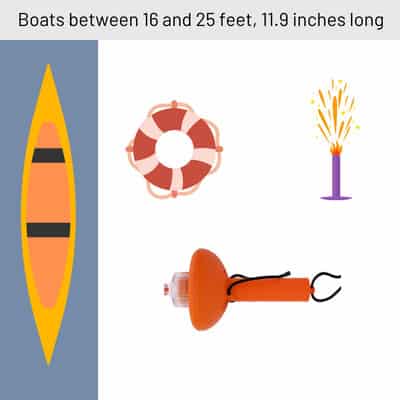
The US Coast Guard requirements for boats over 16 feet but less than 26 feet are similar to the safety equipment needs of a sub-16-foot vessel. For boats under 26 feet, the following additions are crucial.
- One throwable Type IV personal flotation device, such as a life ring, buoyant cushion, or horseshoe buoy (in addition to the one Type I, II, III, and V PFD per person rule).
- Pyrotechnic visual distress signal devices that can last at least three-day or three-night uses (device must have a manufacturing date within 3,5 years). One good example is RLFAA-023-01 Rescue Laser Flare Magnum, which can run continuously for 72 hours.
- Alternative to a pyrotechnic device: one orange distress flag for daytime use and an electronic SOS signal mechanism for nighttime operation
4. Boats between 26 and 40 feet long
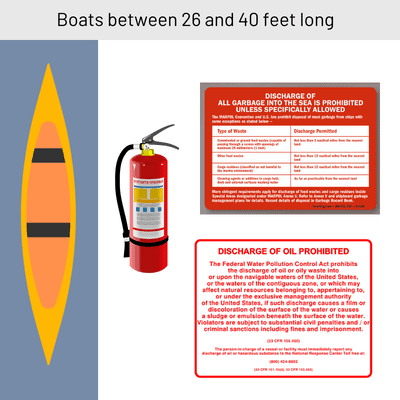
A boat less than 12 meters (39.4 feet) in length but at least 26 feet long has the same safety equipment requirements as smaller vessels. Like the other watercraft sizes, this boat category has unique needs.
- Two B-I type or one B-II type fire extinguisher
- One 4 x 9-inch waste discharge placard
- One 5 x 8-inch oil discharge placard
5. Boats between 40 and 64 feet, 11.9 inches long
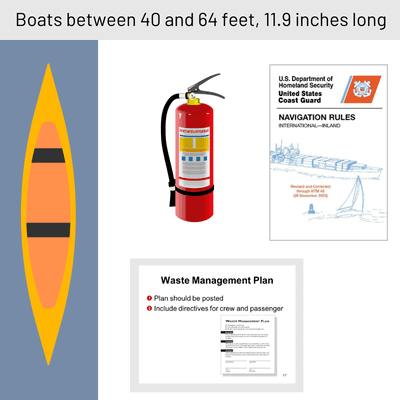
The answer is pretty obvious if you are wondering what must be aboard a vessel between 40 and 65 feet long. You only need the safety equipment outlined in the preceding sections and add the following.
- Three B-I type or one B-I and one B-II type fire extinguishers
- A waste management plan for boats with a galley
- Inland Navigation Rules copy
6. Watercraft between 65 and 164 feet, 11.9 inches long
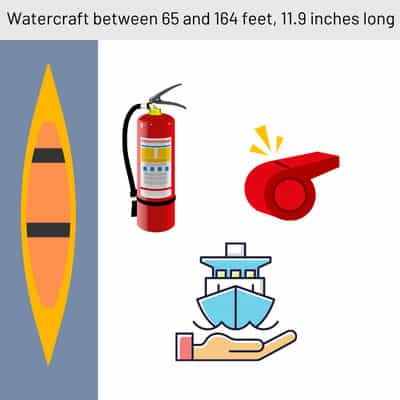
Boats in this category need all the previously-mentioned safety equipment but with a few changes.
- At least one B-II type fire extinguisher for boats weighing less than 50 tons
- At least two B-II type fire extinguishers for boats weighing 50 to 100 tons
- One bell and one horn or whistle (smaller boats only require one sound-producing device)
- Type II or III marine sanitation device for boats with toilet facilities
Why Boaters Must Have These Safety Equipment

The things you need on a boat by law in Florida are understandable. The state holds the record for the most registered recreational watercraft in 2021, with 987,769 vessels.
Unfortunately, the Florida Fish and Wildlife Conservation Commission reported a 16% increase in boating accidents from 723 in 2019 to 836 in 2020, resulting in 79 deaths. This further highlights the importance of safety equipment, which improve your survival chances while boating.
To put things simply, personal flotation devices (PFDs) and other boat safety equipment save lives.
PFDs prevent people from drowning. Sound signaling and visual distress signal devices allow boaters to let other boaters know of their intentions or positions.
Meanwhile, backfire flame arrestors, fire extinguishers, and USCG-standard ventilation systems prevent and control onboard fires.
What Happens When You Are Caught Boating Without the Necessary Safety Equipment Required by Law?

Safety is not the only reason boat regulations Florida boat owners and operators must follow exist. It can also save them from hefty fines and other penalties.
The maximum fine for every missing safety equipment is $1,000, often depending on the type and quantity of the required device.
For example, not having a whistle, horn, or another sound-producing device might get you a $125 fine. On the other hand, missing a personal flotation device might earn you a $50 penalty. Lose three, and you draw a $150 fine.
The law also requires a boat safety kit Coast Guard approved. Hence, non-USCG-approved safety equipment is equivalent to not having the said device in your boat.
Section 327.73 of Florida Statutes Chapter 327 provides a highly detailed “legal consequence” for not having the legally-required safety equipment.
For instance, the civil penalty for such an infraction is $50, which defendants or respondents must pay the fine within 30 days. Failure to comply leads to a second-degree misdemeanor charge.
Alternatively, the respondent can opt not to pay the fine and seek an audience with the county court. However, if the court rules against the respondent, the penalty could be higher but not exceed $500.
Conclusion
What safety equipment is required on a boat in Florida depends on the watercraft’s type and size. As a rule, safety equipment requirements increase in quantity and complexity with increasing vessel size. Hence, a small boat needs fewer safety devices than a large watercraft.
These items might be cumbersome and expensive, but they save lives. They also help you avoid stiff penalties or fines, allowing you to enjoy boat-related leisure activities in Florida.

Ten years of enjoying countless trips on boats never made me love them any less! So I am here to put all those experiences into good use for other boaters who want to have a safe and fun trip with their friends and families.
